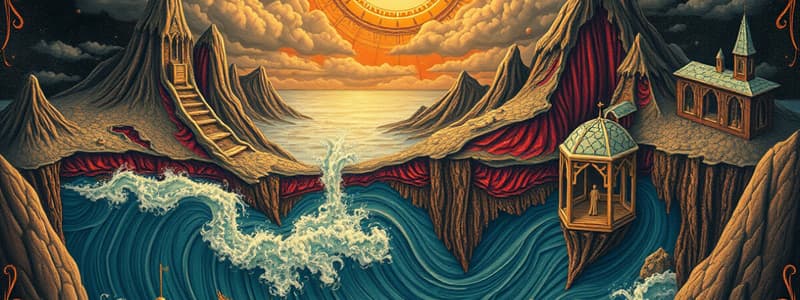Podcast
Questions and Answers
What process occurs when the denser oceanic plate is forced down into the mantle at an oceanic-continental convergent plate boundary?
What process occurs when the denser oceanic plate is forced down into the mantle at an oceanic-continental convergent plate boundary?
- Volcanism
- Continental drift
- Seafloor spreading
- Subduction (correct)
What geological feature is typically formed at oceanic-continental convergent plate boundaries?
What geological feature is typically formed at oceanic-continental convergent plate boundaries?
- Plains
- Fault line
- Volcanic arc (correct)
- Mountain range
Which of the following statements is true regarding the melting of the subducted oceanic crust?
Which of the following statements is true regarding the melting of the subducted oceanic crust?
- It remains unchanged due to pressure.
- It melts because of increased temperature and volatile materials. (correct)
- It melts due to lower mantle density.
- It forms solid rock upon subduction.
What is the purpose of the addition of volatile material, such as water, to the magma during the subduction process?
What is the purpose of the addition of volatile material, such as water, to the magma during the subduction process?
What is the primary cause of earthquakes along oceanic-continental convergent plate boundaries?
What is the primary cause of earthquakes along oceanic-continental convergent plate boundaries?
Which of the following trenches is noted as one of the deepest in the world?
Which of the following trenches is noted as one of the deepest in the world?
At an oceanic-continental convergent plate boundary, which plate is generally subducted?
At an oceanic-continental convergent plate boundary, which plate is generally subducted?
Flashcards are hidden until you start studying
Study Notes
Convergent Plate Boundaries
- Convergent plate boundaries involve the collision of different types of crustal plates: oceanic vs. continental, oceanic vs. oceanic, and continental vs. continental.
Oceanic-Continental Convergent Plate Boundaries
- Oceanic-continental convergence occurs between an oceanic crust plate and a continental crust plate.
- The denser oceanic plate's leading edge bends towards the mantle due to its higher density compared to the continental plate.
- This bending and descent of the oceanic plate into the mantle is known as the subduction process.
- The mantle, being hotter than the crust, melts the subducted oceanic crust, generating magma.
- The addition of volatile materials, such as water, reduces the density of the magma, allowing it to rise towards the continental crust.
- The rising magma can lead to the formation of volcanic arcs at the edge of the continental crust.
- Continuous interaction between converging plates causes frequent earthquakes due to their grinding against each other.
- An important geological feature formed at oceanic crust convergence is a trench, also known as a submarine valley.
- The Philippine Trench is one of the world's deepest trenches, reaching a depth of 10,540 meters.
Studying That Suits You
Use AI to generate personalized quizzes and flashcards to suit your learning preferences.




